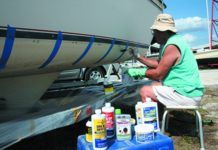Flush-mount Through-Hulls
Can you provide some advice based on your experience with Viva?
Ive gone and bought a Hughes Northstar 38. It has a number of different sized, molded-in deck, seat, and cockpit scuppers, all plumbed together with some old flexible (sic) hoses and Ts to two below-the-waterline through-hulls with gate valves (frozen). I have visible deck/water intrusion at one 1/2″ scupper and leaks belowdecks at connections. Two are at the seat/back radius to drain when heeled.
My current plan is to oversize the holes, remove and epoxy the balsa surrounding the area, re-drill, countersink to flush with deck, and caulk with 3M 5200.
Questions: What scupper material should be used? What material for hoses and fittings? Where can one obtain a countersinking tool that wont destroy gel coat? Any thoughts on the seat radius scuppers? I believe I know what to do with the gate valves!
Re-bedding everything on deck quickly is a priority. Id like to get her in the water, so were working from the bottom up!
Dave Ahlers
via email
We would replace the scuppers with plastic fittings, preferably Marelon (by Forespar) as they are more UV resistant than plain white nylon/plastic. But they arent going to sink the boat if they fail. For hose from a scupper to a junction box we would use reinforced vinyl, the kind with red and blue threads running through them. Dont use plain vinyl for anything. For the hose from the junction boxes to the through-hulls, use either white PVC sanitation hose or black rubber, such as exhaust hose.
Yes, the gate valves must go! Now!
As for cutting beveled holes for tapered, flush-mount through-hulls, we asked occasional PS contributor Bill Seifert for his thoughts. Bill has worked for Tartan, Alden and TPI. He currently runs a yacht management business. Heres what he had to say:
The manufacturers of flush through-hulls make plugs which a boatbuilder just screws to the mold and lays up over-instant recess, complete with a groove for bedding. Installing them in the field is another matter. I have seen homemade cutters in various boatyards which do not meet OSHA safety standards, or even come close.
If a guy wants to put one through hull into a solid hull, Id mark the cutting depth with masking tape on the outside of a hole saw of the right diameter to cut a hole equaling the small diameter of the taper.
Then Id carefully make a hole of a depth equaling the flange thickness of the through hull, Id use a cold chisel to chip out the glass, then a rotary rasp to bevel the sides of the hole to match the taper of the flange. Then Id drill the hole for the stem of the through hull.
The next step is to make an interior backing plate, dry fitting the through-hull to determine the shape of the backing plate, as hulls are rarely parallel inside and outside. If the depth of the cutout for the flange is more than 25% of the hull thickness, I would use at least a 1/4″ thick fiberglass backing plate, and set it in an epoxy and chopped fiber mush to bond to the hull. If the through-hull is liberally coated with something like Vaseline, it can be used with its interior locking nut as a clamp to hold the backing plate parallel to the through hull flange while the epoxy kicks.
If the through-hull is going to be screwed directly into a seacock, it will probably need to have its stem cut down in length (this is why through hulls have straight rather than tapered pipe threads).
If the through-hull is going in a cored hull, the core needs to be replaced with epoxy mush at least 1″ around the perimeter of the stem hole.
One common mistake amateurs make is to make tolerances too tight, and not leave room for bedding. Also, they over tighten through-hulls during installation and squeeze out all the bedding.




































